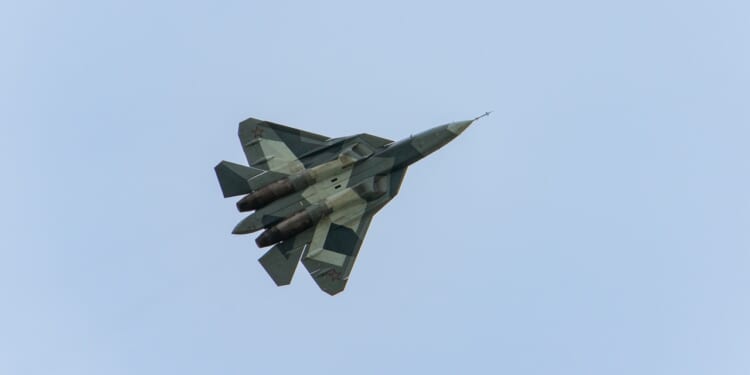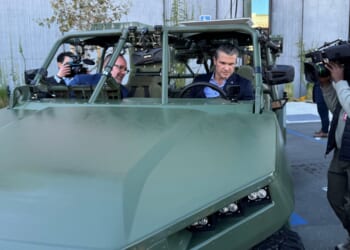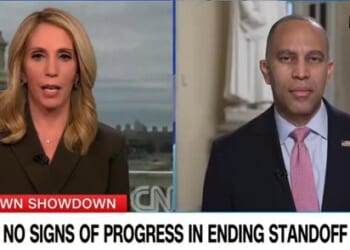The Algerian Air Force, one of the largest in North Africa, has long relied on Soviet and Russian military aircraft.
Russia’s United Aircraft Corporation (UAC), a subsidiary of the state-owned military industrial conglomerate Rostec, had announced last year that it would significantly increase production of its fifth-generation Sukhoi Su-57 (NATO reporting name “Felon”) multirole fighter. In addition to building additional aircraft for the Russian Aerospace Forces, UAC has sought to attract foreign buyers for the export model of the Su-57.
Talks with India for the jet have continued, with New Delhi considering a licensing deal that would give it technology transfer, the rights to local production, and even assistance from Moscow to aid the Indian Advanced Medium Combat Aircraft (AMCA) program. Russia appears to be on the verge of striking a similar deal with Algeria, a major power in North Africa.
Why Algeria Wants a Dozen Su-57 Fighter Jets
There have been reports for more than a year that Algeria would be the first export country to adopt the Su-57, but few details actually emerged until this month. However, according to leaked Rostec documents obtained by the hacker group Black Mirror and posted on social media, Algiers could receive as many as 12 Su-57Es, the export variant developed for international customers.
Algeria previously concluded a deal to receive 14 Su-34ME (NATO reporting name “Fullback”) as part of a deal that was concluded in 2019. The first of those aircraft was delivered last year and is undergoing flight testing, with the total order originally slated to be completed by 2026. Given the state of Russia’s aerospace industry, however, it is unclear if that timeline will still be met.
The Algerian Air Force has long relied on Soviet and Russian military aircraft. Its fleet includes a mix of Mikoyan MiG-29 (NATO reporting name “Fulcrum”) and Sukhoi Su-30MKA (NATO reporting name “Flanker-H”) fighters, as well as older Sukhoi Su-24 (NATO reporting name “Fencer”) tactical bombers. It is likely that, in addition to a small number of Su-57s, Algiers could turn to Moscow for additional Su-30s and perhaps Sukhoi Su-35 Super Flankers to bolster its military aerial capabilities. This is especially relevant as Morocco, Algeria’s neighbor and perennial regional rival, has expressed interest in the US-made Lockheed Martin F-35 Lightning II.
Russian Aircraft Are Heading to Iran, Too
If the leaked documents are genuine and accurate—and there is no reason to believe they are not—Algeria may not be the only nation that could see its air force significantly bolstered by Russian-made aircraft. The documents indicated that Iran is on track to receive 48 Su-35s, with deliveries to begin in 2026 and continue through 2028.
“The potential deliveries, if confirmed, would mark one of Russia’s largest fighter export cycles in a decade,” explained United24Media, a Ukrainian state media outlet. It added, “Both Iran and Algeria have long been seen as key markets for Russian defense industries, but neither government has publicly confirmed the deals.”
The question, much like that with Algeria’s aircraft, is whether Moscow will be able to adhere to such a timeline for the Islamic Republic’s fighters, given the demands it faces in its ongoing war in Ukraine. A January 2025 report from the Jamestown Foundation found that Russian arms exports fell by 92 percent between 2021 and 2024, as production for export was instead rerouted for Russian forces in Ukraine. Meanwhile, a Stockholm International Peace Research Institute study noted that Russia dropped from the second-largest arms exporter to third, surpassed by France.
There is no denying that Algeria, facing a North African arms race with Morocco, and Iran, which is seeking to maintain its position in the Middle East, would not each desire advanced Russian aircraft. Likewise, Moscow would like to retain its place as a significant military hardware exporter. It is a matter of whether all the stars can align to make it happen.
About the Author: Peter Suciu
Peter Suciu has contributed over 3,200 published pieces to more than four dozen magazines and websites over a 30-year career in journalism. He regularly writes about military hardware, firearms history, cybersecurity, politics, and international affairs. Peter is also a contributing writer for Forbes and Clearance Jobs. He is based in Michigan. You can follow him on Twitter: @PeterSuciu. You can email the author: [email protected].
Image: Shutterstock / Marinodenisenko.


















